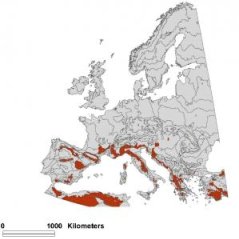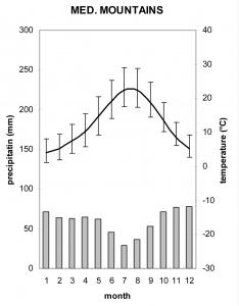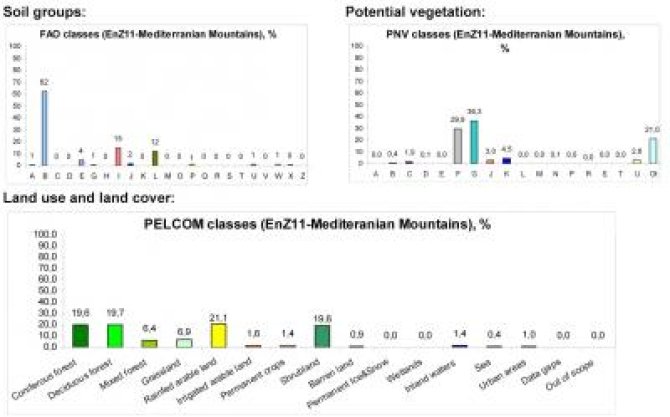
Mediterranean mountains (MDM)
The Environmental zone Mediterranean Mountains consists of low- and medium mountains in the northern part of the Mediterranean and high mountains in the southern Mediterranean. Unlike the Alpine classes, glacial abrasion is not important or nonexistent in this zone; instead the relief is severely affected by water erosion.

Compared to other Mediterranean zones the Mediterranean Mountains receive more precipitation. This and difficult access to the mountains preserve the natural vegetation of the region – deciduous and coniferous forests. Primary and secondary (various stages of degradation) shrub formations (e.g. maquis, garriga, carrascal, phrygana, shibliak) are also very common. The growing season lasts 298 days (271-353), the sum of temperatures above +10°C is 4548° (3984°-5833°-).

The Geologic structures are Alpine structures; the eastern Cantabrians are in the mantle of young (Epi-Palaeozoic) platform. These are built up by Cretaceous deposits. Montes de Toledo, Cordillera Cantabrica and Massif Central are of Hercynian origin. The axial zone of Sierra Nevada is underlaid by Archaean, the axial zone of Sierra de Segovia by Jurassic. Its outer ranges, the Sierra de los Filabres, and segments in Peloponnesus belong to the Alpine orogenic belt; Montes de Toledo are Hercynides, The outer ranges of East Pyrenees and the Corsican mountains are of Palaeocene formations and magmatic rocks, The southern periphery of the Maritime Alps are dominated by Triassic, Jurassic, Cretaceous and Miocene, the East periphery by undifferentiated Mesozoic and various Neocene, Balkan segments by Cretaceous, Palaeocene and Eocene deposits.
The Quaternary deposits are found as diluvial-colluvial in the East Cantabrians, colluvial-proluvial in the Alps, eluvial-deluvial and diluvial-colluvial in the highest ranges in North Dinarian alps.
The potential Natural vegetation is partly Mediterranean evergreen forest (Quercus ilex, Quercus macrolepis), but mostly Beech forests that dominates the higher parts of the Mediterranean mountains. In the Cantabrian mountains the higher elevations are characterized by Quercus pyrenaica forests. The land use is dominated by grazing of transhumance flocks and small scale agriculture mostly on terraces.
